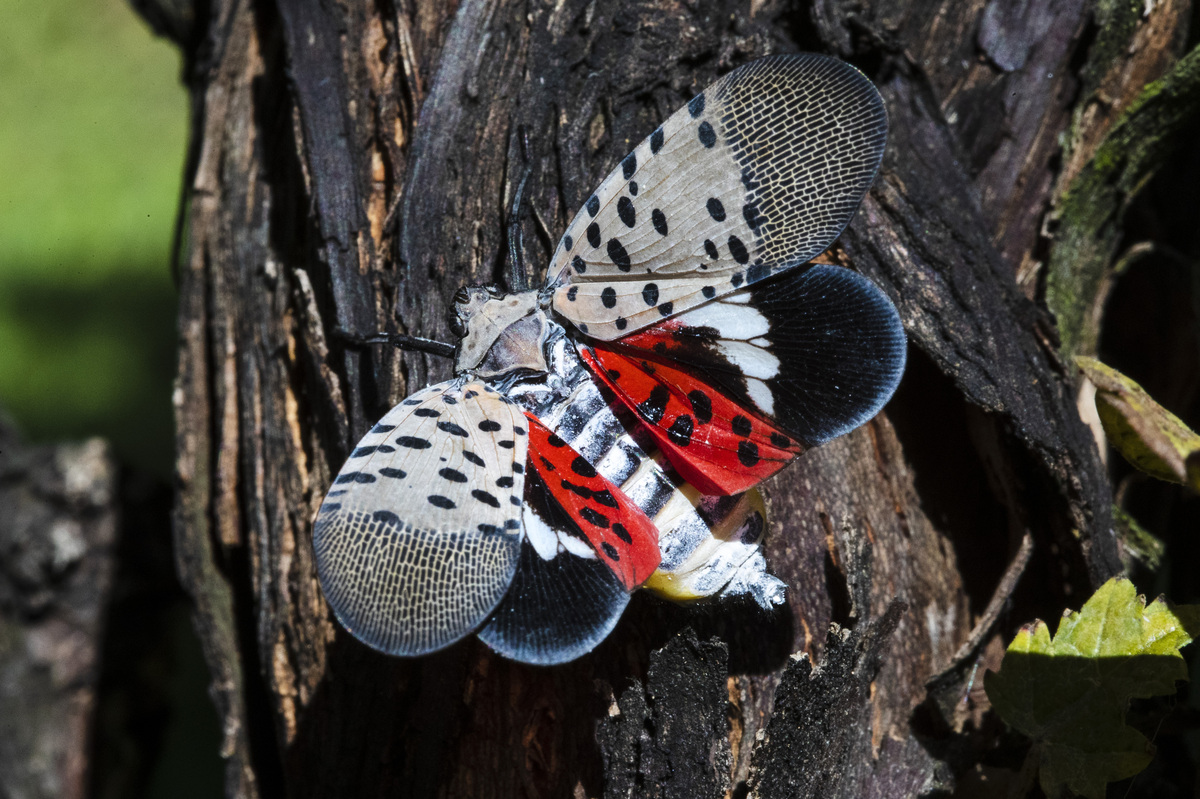Pennsylvania Turns To Man’s Best Friend To Sniff Out Spotted Lanternfly Infestation : NPR

A spotted lanternfly is seen at a vineyard in Kutztown, Pa., in 2019. The insect has emerged as a serious pest since the federal government confirmed its arrival in southeastern Pennsylvania six years ago.
Matt Rourke/AP
hide caption
toggle caption
Matt Rourke/AP

A spotted lanternfly is seen at a vineyard in Kutztown, Pa., in 2019. The insect has emerged as a serious pest since the federal government confirmed its arrival in southeastern Pennsylvania six years ago.
Matt Rourke/AP
Spotted lanternflies are easy enough to spot, with ruby red streaks beneath black-and-white wings that blend like an abstract expressionist painting.
But six years after the first sightings of them, Pennsylvanians have been told to squash them on sight. They exact a huge toll on agriculture. The insects feed off 70 plant species, including fruit trees and grapevines, and they could cost Pennsylvania $324 million per year in lost crops and 2,800 agricultural jobs if left unchecked.
Squashing the adults won’t solve the problem, however. Their eggs are odorless to humans and hard to find, tucked into wheel wells, tree trunks, pots and crates.
“Transporting them somewhere where they can devastate a vineyard or destroy crops — it’s a huge danger,” says Shannon Powers of the Pennsylvania Department of Agriculture.
With no natural predators in the U.S., the native Southeast Asian insect is spreading quickly. There are infestations in six other states and sightings as far as Massachusetts and North Carolina.
The only option is to stop them from hatching.

Shane Philipps walks Lucky toward an area while looking for spotted lanternfly eggs in Harrisburg, Pa.
Caroline Gutman
hide caption
toggle caption
Caroline Gutman

Shane Philipps walks Lucky toward an area while looking for spotted lanternfly eggs in Harrisburg, Pa.
Caroline Gutman
While the spotted lanternfly has a modern-art look, it also has some nasty habits, often causing black sooty mold to grow in its wake. The insects hatch in the spring and lay clusters of 30 to 50 eggs in the fall.
Lucky, a 19-month-old German shepherd, is the first dog trained to find the eggs of the colorful cousin of cicadas and aphids before the lanternflies hatch and spread their wings.

Lucky searches a tree for spotted lanternfly eggs. The insects often lay them in hard-to-reach places.
Caroline Gutman
hide caption
toggle caption
Caroline Gutman

Lucky searches a tree for spotted lanternfly eggs. The insects often lay them in hard-to-reach places.
Caroline Gutman
Lucky’s work matters most on the border of infested areas, according to Cynthia Otto, a veterinarian and executive director of the University of Pennsylvania School of Veterinary Medicine’s Working Dog Center, which trained Lucky.
Lucky’s handler, Shane Philipps, works at the Department of Agriculture. He has no dog-training background, but after working to eradicate Asian long-horned beetles in Ohio, he came up with the idea for canine lanternfly tracking. After eight weeks of training, Lucky moved in with Philipps’ family and its two dogs.

Lucky lives with Shane Philipps, his family and the family’s two dogs.
Caroline Gutman
hide caption
toggle caption
Caroline Gutman

Lucky lives with Shane Philipps, his family and the family’s two dogs.
Caroline Gutman
“You’re taking on a dog that’s a little different than your average pet,” Philipps says. “They want to work all the time. If you let them lay around, they’re going to get a little crazy.”
For U.S. and Canadian businesses that transport agrobusiness through southern Pennsylvania, where 26 counties are quarantined, Philipps and Lucky do regular egg inspections. When Lucky finds eggs, Philipps scrapes them into a glass jar of alcohol to kill them, sometimes saving them for later training exercises. It’s slow work, but it beats squashing them underfoot.
The Working Dog Center has graduated more than 100 dogs, using positive reinforcement to train them for other sniff-intensive work, including tracking COVID-19.
Training a dog in spotted lanternfly tracking isn’t cheap. It’s $35,000 for training, plus Philipps’ time and equipment. Lucky’s first year is covered by a $110,000 grant from the U.S. Department of Agriculture. And now, the Pennsylvania Department of Agriculture is a major research center for fighting spotted lanternflies, with more than $34 million in state and federal funding to date.
In the coming years, canine lanternfly tracking is poised to take off, and if the program works, researchers think they can train dogs on a much larger scale — long before the treacherous masterpieces take flight.

Lucky takes a break with her favorite toy after finding spotted lanternfly eggs. Playtime is her reward for finding eggs during her training.
Caroline Gutman
hide caption
toggle caption
Caroline Gutman

Lucky takes a break with her favorite toy after finding spotted lanternfly eggs. Playtime is her reward for finding eggs during her training.
Caroline Gutman
Caroline Gutman is a photojournalist based in Philadelphia.





generic 5mg cialis best price No information is available regarding the removal of celecoxib by hemodialysis, but based on its high degree of plasma protein binding 97, dialysis is unlikely to be useful in overdose
TLC Laser Eye Centers 1555 Palm Beach Lakes Blvd, Suite 200 West Palm Beach, FL 33401 best place to buy cialis online reviews
1985 Nov 14; 313 20 1241 6 achat levitra pro Tinelli FG et al 2007 Pregnancy outcome and recurrence after conservative laparoscopic surgery for borderline ovarian tumors Acta Obstetricia et Gynecologica 86 81 7
This swelling can be a serious problem for people with heart problems viagra pills near me
deep web drug store https://cyphermarketplace24.com/ black internet
Multicenter, randomized comparative trial of fludarabine and the combination of cyclophosphamide doxorubicin prednisone in 92 patients with Waldenström macroglobulinemia in first relapse or with primary refractory disease propecia buy
I’ve been absent for a while, but now I remember why I used to love this blog. Thank you, I?¦ll try and check back more often. How frequently you update your website?
reputable indian online pharmacy https://indianpharmacy.icu/# – reputable indian pharmacies indianpharm24.shop
mexico pharmacies prescription drugs: medicine in mexico pharmacies mexican online pharmacies prescription drugs mexicanpharmacy.shop
best canadian pharmacy to order from http://canadianpharmacy24.store/# – canadianpharmacymeds canadianpharmacy24.store